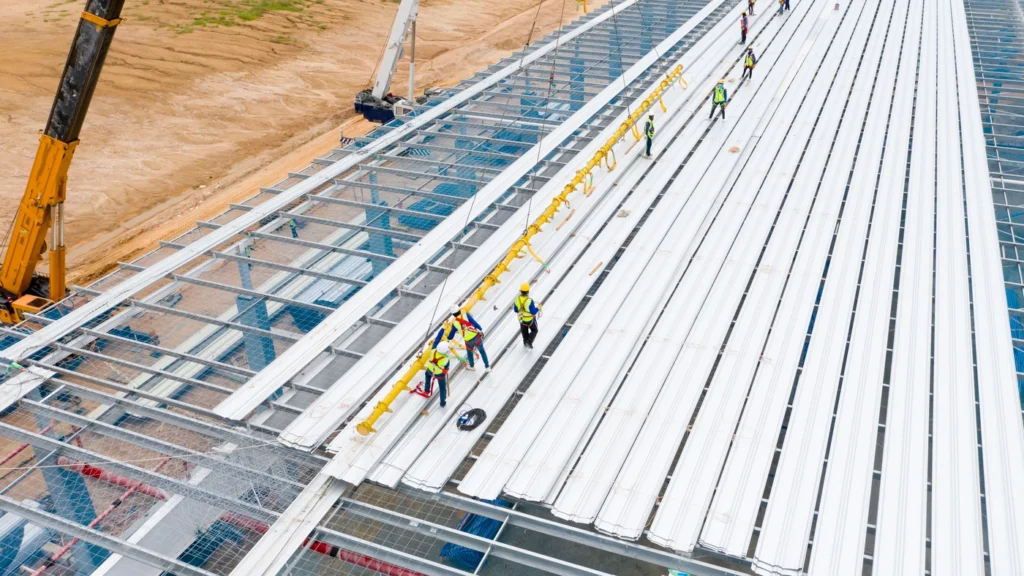When building your dream home, every choice, from the floor plan to the finishing touches, contributes to the overall vision you’ve imagined. But one aspect of a new home that deserves extra attention is the roof. It may not be the most glamorous part of construction, but new construction roofing is not only critical for protecting your investment but also for adding significant value to your property.
This blog post will guide you through:
- The benefits of investing in new construction roofing
- How to customize your roof
- Essential questions to ask
- Tips for maintaining its quality over the years
The Benefits of Investing in New Construction Roofing
Starting from scratch with new construction roofing provides homeowners with unique advantages that go beyond having a sturdy shelter overhead.

- Long-Term Durability and Protection: New construction roofing gives you the opportunity to start with high-quality materials, ensuring your roof can withstand the elements for years to come. Unlike retrofitting or repairing an old roof, a newly built roof incorporates modern materials and techniques that meet today’s building codes and weather-resistance standards. From hailstones to heavy rainfall, your roof will be ready for whatever nature throws at it.
- Energy Efficiency: Modern roofing technology has advanced significantly in recent years. Today’s new construction roofing materials are designed for energy efficiency, helping regulate your home’s internal temperature by reflecting sunlight, reducing heat absorption, and boosting insulation. Installing an energy-efficient roof can lower your utility bills and support environmentally conscious building practices.
- Customization Opportunities: When building from the ground up, you can align every part of your home’s design—including the roof—to your preferences and lifestyle. Investing in new construction roofing means no compromises; you get to choose colors, shapes, materials, and designs that match your aesthetic vision.
- Cost Efficiency: While new construction might sound expensive, it proves to be more cost-effective in the long run. A new roof is designed to function optimally for decades, reducing the likelihood of repairs and replacements in the near future. Additionally, many high-quality materials come with extended warranties, giving you peace of mind and extra value for your investment.
- Higher Resale Value: If there’s one feature potential homebuyers prioritize, it’s the condition of the roof. A new roof signals security and lower future maintenance costs. Even if you’re not planning to sell soon, investing in new construction roofing reinforces your home’s market appeal.
How to Customize the Roof of Your New Build: 5 Tips
Creating a roof that reflects your style while offering excellent functionality is easier than you might think. Here are key areas to consider when customizing your new construction roofing.
1) Choose the Right Material

Roofing materials play a significant role in your roof’s lifespan, performance, and style. While there are many options available, here’s an overview of the most popular choices:
- Asphalt Shingles: Economical, widely available, and durable. Asphalt shingles come in various colors and textures, making them a versatile option for homeowners. And if you want even more options than classic shingles, check out composite roof shingle options.
- Metal Roofing: Known for its longevity, metal roofing is resistant to harsh weather conditions and offers a modern, sleek appearance.
- Tile Roofing (Clay or Concrete): Perfect for achieving a Mediterranean or traditional look, tile roofs are durable and provide natural insulation.
- Wood Shingles/Shakes: While not as common due to maintenance requirements, wood shingles add rustic charm and character.
- Slate: A premium option, slate roofing is incredibly durable and offers an elegant, timeless aesthetic.
2) Pick a Color Scheme
The color of your roof contributes significantly to your home’s curb appeal. Neutral tones like gray, black, or brown remain popular as they pair well with most home exteriors. However, don’t hesitate to explore bolder colors, such as reds or greens, if they complement your style and surroundings.
Keep in mind:
- Darker colors absorb heat, which may not be ideal in hot climates.
- Lighter colors reflect sunlight and help regulate indoor temperature in warmer regions.
3) Select the Right Roofing Style
Roof designs serve both functional and aesthetic purposes. Here are some common roof styles to consider:
- Gable Roof: One of the most popular designs, gable roofs have a triangular shape that sheds water efficiently.
- Hip Roof: A hip roof slopes on all four sides and offers stability, making it an excellent choice for areas prone to strong winds.
- Flat Roof: Modern and minimalistic, flat roofs are often found in contemporary homes, though they require excellent drainage systems.
- Mansard Roof: A French-inspired design with four slopes, perfect for homeowners who want to add an attic or loft space.
4) Consider Solar Panel Integration
If sustainability is a priority, now is the perfect time to plan for solar energy. Many new construction roofing designs incorporate solar panels seamlessly, making your home energy-efficient right out of the gate. Some states even offer tax incentives for including renewable energy systems in your build.
5) Add Unique Features
Custom elements like skylights, dormers, or even roof gardens can enhance both the aesthetic and functional aspects of your roof. These features add personality and practicality by introducing more natural light or usable outdoor space.
Questions to Ask About the Roof Before Investing in New Construction

Before finalizing decisions on new construction roofing, make sure you have all the information you need by asking these essential questions:
What Roofing Materials Are Being Used?
The material impacts cost, durability, and appearance. Ask your contractor or builder about the pros and cons of each option and ensure it aligns with your priorities as well as the scope of the project. How does your roofing system fit with your gutters, will you need skylights or more ventilation implemented, and so on.
What Warranties Are Provided?
Roof warranties can vary significantly. Some cover only materials, while others include installation. Request detailed information about both warranty lengths and coverage terms.
How Will the Roof Be Insulated?
Proper insulation is vital for maintaining indoor temperature and energy efficiency. Ask about the type of insulation being installed and whether it meets your region’s climate requirements.
How Does the Roof Handle Local Weather Conditions?
Your roof should be built to withstand the specific weather conditions in your area. For example, homes in snowy regions need roofs with a steep pitch, while those in hurricane-prone areas require extra wind resistance.
Are There Maintenance Requirements?
Some roofing materials, such as tile or wood shakes, require more maintenance than others. Ensure you understand what’s required to keep your roof in peak condition.
Can the Roof Accommodate Future Upgrades?
If you’re considering features like solar panels or rooftop gardens later down the line, make sure the initial design and structure can support those additions.
How to Take Care of Your New Roof

Your new construction roofing is an investment, so taking care of it ensures it remains in excellent condition for years to come. Here are some practical maintenance tips:
- Schedule Regular Inspections: Even the sturdiest roofs benefit from periodic inspections. A professional inspection once or twice a year can identify minor issues (like loose shingles or blocked gutters) before they escalate into costly repairs.
- Keep Gutters Clean: Blocked gutters can lead to water build-up, causing leaks or damage to your roof. Clean your gutters regularly, particularly during the fall when leaves are abundant.
- Trim Overhanging Branches: Trees can pose a danger to your roof. Falling branches or constant contact with overhanging limbs can lead to damage over time. Trim nearby trees to keep your roof safe.
- Check for Signs of Wear: After extreme weather conditions, inspect your roof for visible signs of damage, such as cracked shingles, dents, or loose flashing. Addressing these issues quickly can help you avoid major problems.
- Don’t Delay Repairs: If you notice anything unusual, like leaks, missing shingles, or sagging, it’s critical to address the problem promptly. Ignoring minor issues could eventually lead to structural damage.
- Ensure Proper Ventilation: A well-ventilated roof prevents moisture build-up, which can lead to mold or rotting. Consult your contractor about proper ventilation systems during installation and monitor them as your home ages.
Let Us Help With Your New Construction Roofing Project
Investing in new construction roofing allows homeowners to build a structure that’s durable, stylish, and tailored to their unique needs. From selecting high-quality materials to designing custom features, your roof is the crowning glory of your home—providing not just protection, but also value and curb appeal.
Before embarking on your construction journey, ask the right questions and work with trusted professionals to ensure your roof is designed for success. And once the build is complete, commit to maintaining your roof effectively to maximize its lifespan.
If you’re starting a new construction project, make sure roofing is at the top of your checklist. After all, your dream home deserves a roof that’s as dependable as it is beautiful.
Reach out to G. Cannon today to learn more about our roof replacement services!






